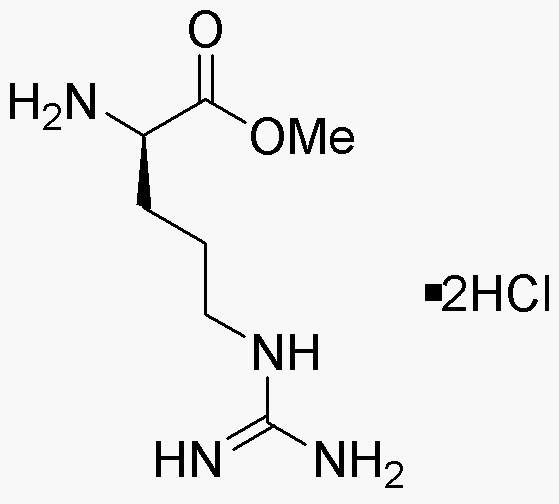D-Arginine methyl ester dihydrochloride is widely utilized in research focused on:
- Pharmaceutical Development: This compound serves as a precursor in the synthesis of various pharmaceuticals, particularly those targeting cardiovascular and metabolic disorders.
- Biochemical Research: It is commonly used in studies involving nitric oxide synthesis, which is crucial for understanding vascular health and function.
- Protein Engineering: Researchers utilize it to modify proteins and peptides, enhancing their stability and activity for therapeutic applications.
- Cell Culture Studies: The compound is employed in cell culture media to promote cell growth and viability, especially in studies related to muscle and nerve cells.
- Cosmetic Formulations: Its properties make it beneficial in skincare products aimed at improving skin hydration and elasticity, appealing to the cosmetic industry.
General Information
Properties
Safety and Regulations
Applications
D-Arginine methyl ester dihydrochloride is widely utilized in research focused on:
- Pharmaceutical Development: This compound serves as a precursor in the synthesis of various pharmaceuticals, particularly those targeting cardiovascular and metabolic disorders.
- Biochemical Research: It is commonly used in studies involving nitric oxide synthesis, which is crucial for understanding vascular health and function.
- Protein Engineering: Researchers utilize it to modify proteins and peptides, enhancing their stability and activity for therapeutic applications.
- Cell Culture Studies: The compound is employed in cell culture media to promote cell growth and viability, especially in studies related to muscle and nerve cells.
- Cosmetic Formulations: Its properties make it beneficial in skincare products aimed at improving skin hydration and elasticity, appealing to the cosmetic industry.
Documents
Safety Data Sheets (SDS)
The SDS provides comprehensive safety information on handling, storage, and disposal of the product.
Product Specification (PS)
The PS provides a comprehensive breakdown of the product’s properties, including chemical composition, physical state, purity, and storage requirements. It also details acceptable quality ranges and the product's intended applications.
Certificates of Analysis (COA)
Search for Certificates of Analysis (COA) by entering the products Lot Number. Lot and Batch Numbers can be found on a product’s label following the words ‘Lot’ or ‘Batch’.
*Catalog Number
*Lot Number
Certificates Of Origin (COO)
This COO confirms the country where the product was manufactured, and also details the materials and components used in it and whether it is derived from natural, synthetic, or other specific sources. This certificate may be required for customs, trade, and regulatory compliance.
*Catalog Number
*Lot Number
Safety Data Sheets (SDS)
The SDS provides comprehensive safety information on handling, storage, and disposal of the product.
DownloadProduct Specification (PS)
The PS provides a comprehensive breakdown of the product’s properties, including chemical composition, physical state, purity, and storage requirements. It also details acceptable quality ranges and the product's intended applications.
DownloadCertificates of Analysis (COA)
Search for Certificates of Analysis (COA) by entering the products Lot Number. Lot and Batch Numbers can be found on a product’s label following the words ‘Lot’ or ‘Batch’.
*Catalog Number
*Lot Number
Certificates Of Origin (COO)
This COO confirms the country where the product was manufactured, and also details the materials and components used in it and whether it is derived from natural, synthetic, or other specific sources. This certificate may be required for customs, trade, and regulatory compliance.


